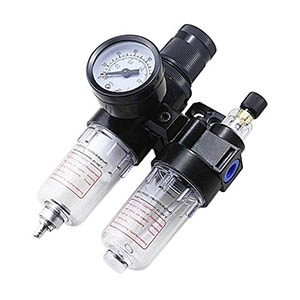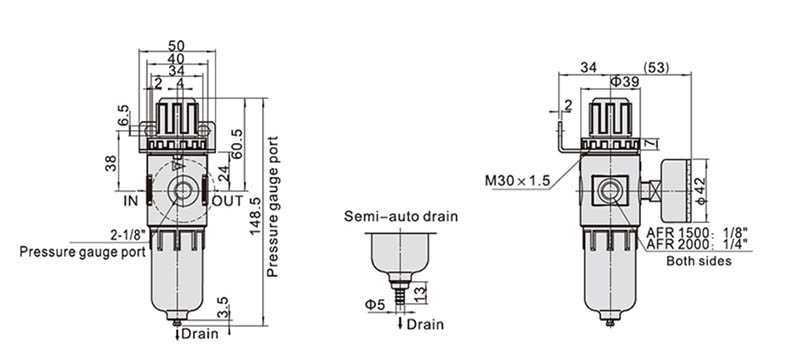Air Filter Regulator: How Does it work?
An air filter is a device composed of fibrous or porous material that removes solid particles such as dust, pollen, mold, and bacteria from the air. Filters containing adsorbents or catalysts also remove odors and gaseous pollutants. Air filters are generally used in clean workshops, laboratories and clean rooms, or for dust prevention of electronic mechanical communication equipment. There are many types of filters. It is mainly divided into primary filter, intermediate filter, high efficiency filter and sub-high efficiency models. Various models have different standards and performance.
Air filter regulator structure
In pneumatic technology, the air filter, pressure reducing valve and lubricator are called the three major pneumatic components. In order to obtain a variety of functions, these three air source processing components are often assembled together in sequence, which is called a pneumatic air filter triple. For example, in ATO, its name is an air filter regulator, which is used for air source purification and filtration, decompression and provide lubrication.
The installation sequence of the three major parts is air filter, pressure reducing valve and lubricator according to the direction of air intake. The three major parts are indispensable air source devices in most pneumatic air filter (ATO possess related product 1/8" 1pc Pneumatic Filter) systems. They are installed near the gas equipment and are the final guarantee of compressed air quality. In addition to ensuring the quality of the three major parts, space saving should also be considered in their design and installation. Easy operation and installation, can be combined arbitrarily and other factors.
Due to the composition of three major parts, the operation process of the air filter is more complicated than that of ordinary filters, which means that its functions are also increased. Next, let us understand the filtering principle of the air filter, and at the same time, we can further understand why the filter needs to be replaced in time under the condition of long-term use.

Working principle
The filter principle of the air filter regulator separates the liquid water and liquid oil droplets in the compressed air, and filters out the dust and solid impurities in the air. Airborne particulate matter removal technologies mainly include mechanical filtration, adsorption, electrostatic dust removal, negative ion and plasma methods, and electrostatic filtration.
Electrostatic adsorption
When an object with static electricity is close to another object without static electricity, due to electrostatic induction, the object without static electricity will be charged with a charge of the opposite polarity to the charge carried by the charged object. Because the opposite charges attract each other, it will show electrostatic adsorption phenomenon. Electrostatic adsorption is particularly effective for particles smaller than 1 micron in size.
Mechanical filtration
Generally, particles are captured in the following three ways: direct interception, inertial collision, and Brownian diffusion mechanism. It has a good collection effect on fine particles but has a large wind resistance. In order to obtain high purification efficiency, the filter element needs to be dense and replaced regularly.
The dust that is controlled and filtered by clean technology is generally 0.1---10μm dust particles with a small particle size, including solid particles and liquid particles; organic particles suspended in the atmosphere. It also includes microorganisms, plant pollen, catkins and fluff. Microorganisms generally include Viruses, bacteria, fungi, protozoa and algae.
The fibers inside the air filter are intricately arranged to form countless grids. When particles of a certain size move along the airflow to the vicinity of the fiber surface, if the particle size is greater than or equal to the fiber spacing, the particles will be intercepted and deposited on the fiber surface.
When the dust airflow passes through the fiber layer of the air filter, due to the complex arrangement of the fibers, the airflow turns violently many times. When the particle mass is large or the flow velocity is high, and the airflow turns, part of the particles cannot follow the airflow and bypass the fiber due to inertia, so they leave the airflow and approach the fiber, and collide with the fiber to deposit.
The Brownian diffusion motion of the particles is generated due to the collision of the thermal motion of the gas molecules on the particles, and the smaller the particles, the more significant the effect. Brownian diffusion gives particles a greater chance of moving to the surface of the fiber for deposition. When the particles pass through the fiber layer of the filter, they are displaced from the air flow under the action of gravity, that is to say, they are deposited on the fibers due to gravity settlement.

Application
The air filter is to obtain clean air that can meet the standard. The general ventilation filter is to capture and absorb dust particles of different sizes in the air to improve the air quality. In addition to absorbing dust, the chemical filter can also absorb odor, usually used in biopharmaceuticals, hospitals, airport terminals, human settlements and other places. Generally, air filters for ventilation are widely used, and are needed in the microelectronics industry, painting industry, food and beverage industry, etc. In other words, the filter is just a means, in order to achieve the goal of cleanliness, we need to choose the appropriate air filter regulator according to the actual situation.
Biological clean rooms
Air purification controls mainly bacteria, fungi, and viruses. Because microorganisms are mainly attached to dust particles, effective control of dust particles in the air can also effectively control bacteria, fungi and viruses. To do this, it must pass through a particle filter with barrier properties before it can be filtered. Generally, the filtration efficiency of ordinary high-efficiency air filters for bacteria can reach 99.996%, which can basically meet the filtration and purification requirements of biological clean rooms.
Production workshops
For food production workshops, the requirements for a dust-free and sterile environment are relatively high, especially for some baby food production workshops, such as milk powder factories. At this time, it is necessary to use primary filtration, intermediate filtration, and high-efficiency filtration, and perform multi-stage filtration at the air inlet of the production workshop to make the air entering the workshop meet certain dust-free and sterile requirements. Some food factories will produce very high concentration of exhaust gas due to baking, frying, roasting, fermentation and other processes. Do not discharge directly into the outdoor air at this time. It is necessary to install an air filter at the exhaust outlet to filter the exhaust gas, and it can only be discharged after reaching the standard.
Hospitals
Medical places have high requirements on air quality. In the operating environment of the hospital, a clean environment is required, so the medical air filter is mostly a hospital high-efficiency filter, that is to say, the filter itself has high air purification efficiency, and its internal structure is an ultra-fine glass fiber board. It can absorb excess dust particles in the air, and improve air cleanliness in the air environment. The high-efficiency filter can filter more than 99.99% of particles with a particle size of 0.3μm in the air. Medical places have high requirements on air quality and require air circulation in the hospital space. Medical air filters are generally set in conjunction with air conditioning units. In order to ensure that the purified environment meets the requirements, the medical air filtration process includes a primary filtration process, an intermediate filtration process and a final filtration process. After multi-level air filtration, it can meet the stringent requirements of the medical environment. For wards and activity spaces of different types of patients, medical air filters with different filtration levels can also be set up.

